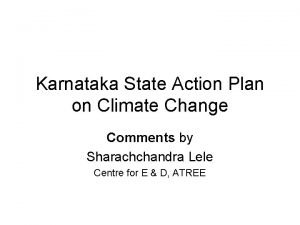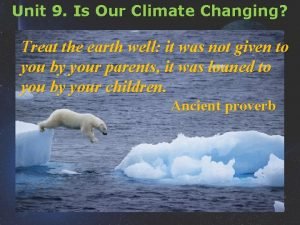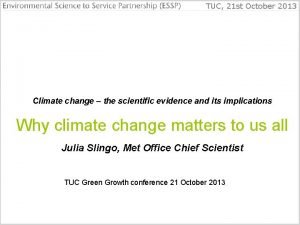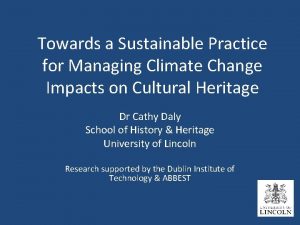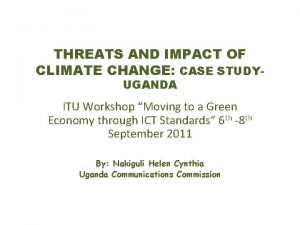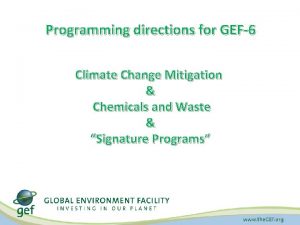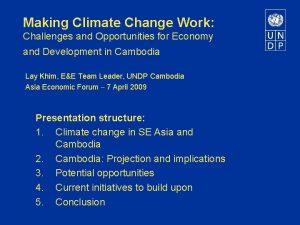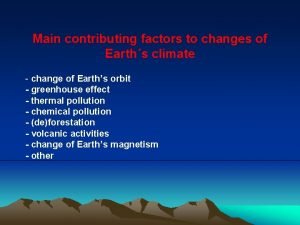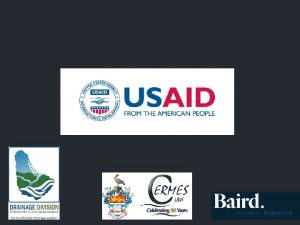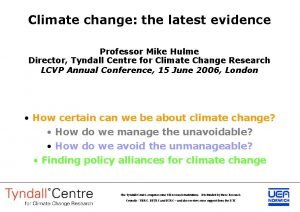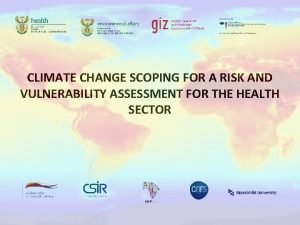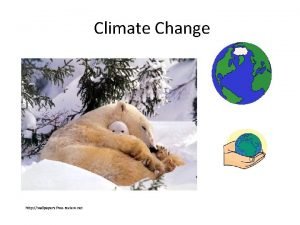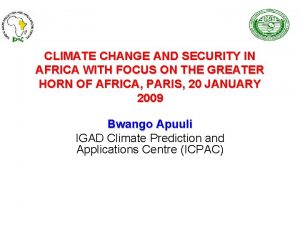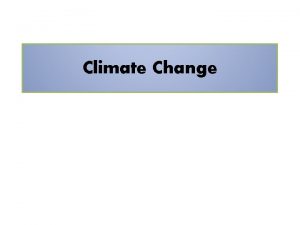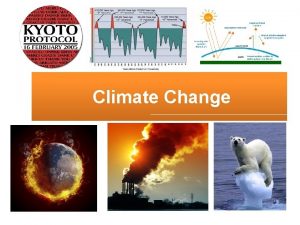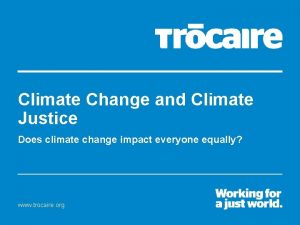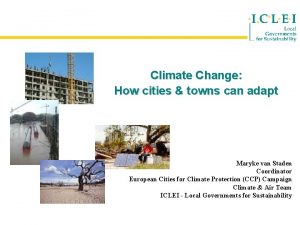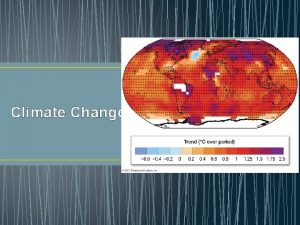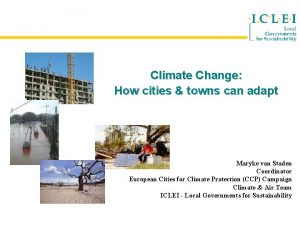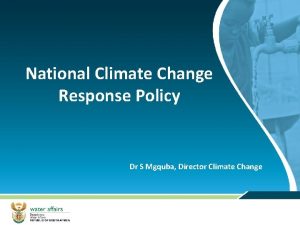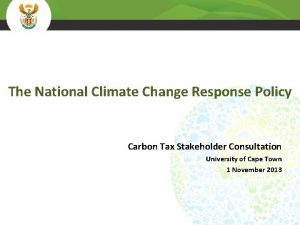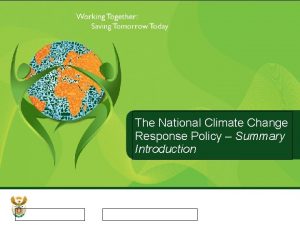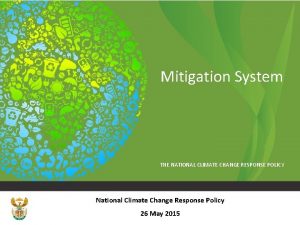The National Climate Change Response Policy The Policy

























- Slides: 25

The National Climate Change Response Policy – The Policy Development Process

Presentation Overview • The early days 1994 to 2005 • The first national climate change conference, October 2005 • Building the science-policy interface 2005 to 2008 – the LTMS case study • Cabinet’s 2008 policy directions • The national climate change response policy conference, March 2009 • The policy development process from 2009 to November 2010 • The Green Paper and the policy finalisation process – Nov 2010 to October 2011

The early days 1994 to 2005 • • The 1 st IPCC Assessment Report published in 1990 presented sufficient scientific evidence of climate change to elicit world wide concern and the negotiation of the United Nations Framework Convention on Climate Change (UNFCCC). In 1994, in response to the growing international concerns around climate change, the Department of Environmental Affairs and Tourism established the National Climate Change Committee (NCCC) The 2 nd IPCC Assessment report published in 1995 demonstrated that the actions outlined in the UNFCCC were insufficient and this motivated the negotiation of the Kyoto Protocol which was finalised in 1997 In response to the findings of the IPCC’s 2 nd Assessment Report and supported by recommendations from the NCCC, the South African Government ratified the UNFCCC in August 1997.

The early days 1994 to 2005 (Continued) • • • By 2001, South African researchers had also started taking a serious look at climate change and its implications. Arguably, climate change rose up the political agenda when, in 2002 the Heads of State of over 180 countries met at the World Summit on Sustainable Development in Johannesburg. In July of 2002 the South African Government acceded to the Kyoto Protocol. By 2003, South Africa had concluded its Climate Change “Country Studies” and 1990 and 1994 greenhouse gas inventories and had submitted these in the form of its Initial National Communication (INC) to the UNFCCC Secretariat. In compiling and finalising the INC it became clear that South Africa was not only a potentially significant victim of the negative impacts of climate change, but was also a significant contributor to greenhouse gases.

would have important policy implications. • By June 2005 the departments of environment and science and technology starting organising a unique climate change conference consisting of two components – The 1 st, starting on a Monday, was a Climate Change Science the. Report, top South In 2005, with conference the 3 rd IPCC involving Assessment it also. African becameand clear that South African scientists; Africa, along with other more advanced developing countries (e. g. China, India, Brazil, Mexico, South Korea would have to start seriously – The 2 nd, starting one and day Saudi later, Arabia), was a Climate Change considering its responsibility climate change and, that, a fossil-fuel-powered Policy conference with for its programme aligned with, asand nation, this would have. Climate important policy Science implications. informed by, the Change conference; – • • By June 2005 the this departments of environment andrevolutionary science and technology – At the time, concept was regarded as starting a unique climate change conference dialogue consisting of two andorganising a real initiation of pragmatic science-policy components – – The 1 st, starting on a Monday, was a Climate Change Science conference involving the top South African and African scientists; The 2 nd, starting one day later, was a Climate Change Policy conference with its programme aligned with, and informed by, the Climate Change Science conference; At the time, this concept was regarded as revolutionary and a real


The 2005 National Climate Change Conference • • • Held in Midrand from 17 to 20 October 2005 under the banner of “Climate Action Now”. Over 600 representatives from government, business, the scientific and academic communities, and civil society Opened by the Deputy President and involving the active participation of 5 Cabinet Ministers and Deputy Ministers, the gathering was broadly considered a reflection of Government’s commitment and determination to act on climate change and to shape policy informed by the best-available science. • The conference unanimously agreed that climate change was a reality • Amongst the many commitments outlined in the “Midrand Plan of Action” – – Initiating a detailed scenario building process to map out how South Africa could meet its UNFCCC Article 2 commitment to greenhouse gas stabilisation whilst


The LTMS • • In March 2006, Cabinet mandated a national process of building scenarios of possible greenhouse gas emission futures, informed by the best available research and information, to define not only South Africa’s position on future commitments under international treaties, but also to shape the country’s climate change policy for the longer-term future. This process became known as the Long-Term Mitigation Scenarios (LTMS) development process. Government appointed the Energy Research Centre at the University of Cape Town to project manage the entire process and they convened and contracted the process specialists and set up the personnel of four focussed Research Support Units The multi-stakeholder Scenario Building Team (SBT) was established in August 2006 to carry out the technical aspects

The LTMS (Continued) Government DEAT Environment DME Minerals & Energy DST Science & Technology Do. T Transport Treasury Foreign Affairs DTI Trade & Industry DPE Public Enterprises DWAF Water Affairs & Forestry Presidency SAWS Weather Service CEF / SA Nat’l Energy Research Institute NERSA Energy Regulator W Cape Province (DEADP) City of Johannesburg Dept of Agriculture ARC Business SASOL Eskom EIUG Energy Intensive Users Group Engen Grain SA Anglo Coal BHP Billiton Chamber of Mines Aluminium – AFSA Kumba Resources Chemical – CAIA Engen Forestry SA Agri. SA Business Unity SA Sappi Envirotech (Waste) Civil society Eco. City/CURES Groundwork SESSA Labour (COSATU) SEA SACAN COSATU SALGA WWF-SA Earthlife Africa NEDLAC

The LTMS (Continued) • On 24 October 2007, after a year of intense work, the initial technical work of the LTMS was signed off by the SBT at their sixth meeting. This work is reflected in the following documents: – – – The “Long-Term Mitigation Scenarios - Strategic options for South Africa”, a 27 page document that synthesizes the findings of the technical research into a tool for informed decision-making The “Long-Term Mitigation Scenarios – Technical Summary”, a 17 page document that provides the technical basis, in abridged form, for the “Long-Term Mitigation Scenarios - Strategic options for South Africa” document The “Long-Term Mitigation Scenarios – Technical Report”, a 153 page report on the LTMS research. This document is also supported by technical reports on: Energy emissions; Non-energy emissions; Macroeconomic analysis; and Climate impacts.

The LTMS (Continued)

The LTMS (Continued)

The LTMS (Continued) • The SBT consensus: – – – • • • “Growth Without Constraints” is an unacceptable trajectory “Current Development Paths” will not significantly change the unacceptable “Growth Without Constraints” trajectory “Required By Science” should be our ‘aspirational’ goal The LTMS was a broadly supported piece of research with findings that are policy relevant not policy prescriptive The LTMS process has been peer-reviewed by international experts and its methodology is considered robust and has been replicated internationally During the LTMS process, apart from an accelerated upswing in climate change related research, another extremely significant policy-related development was the ANC’s strong climate change resolution made at its 52 nd National Conference

Cabinet’s 2008 Policy Directions • • South Africa’s response to climate change was considered during Cabinet’s July 2008 Lekgotla and Cabinet’s decisions were presented to the public on 28 July 2008 Apart from agreeing a process and timetable for the development of a national climate change response policy, Cabinet also directed, among others, that – Climate change mitigation interventions should be informed by, and monitored and measured against the following “plateau and decline” emission trajectory – • Greenhouse gas emissions stop growing (start of plateau) in 202025 • Greenhouse gas emissions begin declining in absolute terms (end of plateau) in 2030 -35.

Cabinet’s 2008 Policy Directions (Continue) • The Socio-economic transition - Transition to climate resilient and low-carbon economy and society – – – • balance our mitigation and adaptation response In the long-term, redefine our competitive advantage and structurally transform the economy by shifting from an energy-intensive to a climate -friendly path as part of a pro-growth, pro-development and pro-jobs strategy Adapt to the inevitable - Continue to pro-actively build the knowledge base and our capacity to adapt to the inevitable impacts of climate change, most importantly by enhancing early warning and disaster reduction systems and in the roll-out of basic services, infrastructure planning, agriculture, biodiversity, water resource management and in the health sector


The 2009 Climate Change Summit • • From 3 -6 March 2009, nearly 900 representatives from government, business, the scientific and academic communities, and civil society and over 150 “virtual participants” linked through the Internet came together in Midrand to initiate a consultative process to develop the South African Climate Change Response Policy. Areas of consensus – – – Pursue ‘required by Science’ Transition to low carbon economy in the context of equity, sustainable development and poverty eradication A strengthened science-policy interface Balance adaptation and mitigation – integrate adaptation into development planning

The 2009 Climate Change Summit (Continue) • Areas of consensus (cont. ) – – Energy efficiency standards – Government coordination and policy alignment – Price on carbon – mix of instruments requires further work – Fast track CDM tax incentives – Massively upscale public awareness – Gender mainstreaming – Mobilise resources including for R+D – Efficiency

From 2009 Summit to the Green Paper • UNFCCC’s 2009 COP 15 in Copenhagen • Round Table on 17 May 2010 – – – • • Provide key climate change response stakeholders with an update on the National Climate Change Response Policy development process Provide a platform for key climate change response stakeholders to respond to, and discuss, the most recent Climate Change Policy Discussion Document Draft Green Paper compiled and initial discussions initiated in July 2010 Final Draft Green Paper approved for publication and published in November 2010

From 2010 Green Paper to 2011 White Paper • • Following Cabinet’s approval to publish for public comment, the National Climate Change Response Green Paper was published in the Government Gazette, departmental web site and in a hard copy version on 27 November 2010. A Green Paper web site was established to facilitate access to all the relevant documentation, provide updates on the process and to provide an electronic means for submitting comments (www. climateresponse. co. za); Productive and fruitful public workshops on the Green Paper were held in each and every province; A series of focussed stakeholder workshops were held on specific policy themes identified during the policy development process including:

From Green Paper to 2011 White Paper (Continued) • • • The department conducted many bilateral engagements and made numerous policy presentations at various forums, seminars and conferences. Parliament hosted a public hearing process on the draft policy stretching over three weeks of stakeholder presentations and robust discussions and debates. The inputs during this period that raised over 4, 000 individual issues on the Green Paper, were captured in a detailed comment/response database The department hosted a drafting retreat from 13 -15 April 2011, where the Intergovernmental Committee on Climate Change (IGCCC) members had an opportunity to review the emerging issues and comments (Rev 1) Following the drafting retreat, a working draft of the White paper was compiled (Rev 2), circulated and presented to the IGCCC on 27 and 31 May 2011 respectively and departments were requested to submit comments on the document by 17 June 2011. By 24 June 2011, comments had been received from the departments of: Energy,

From Green Paper to 2011 White Paper (Continued) • • • A drafting team meeting was held on 27 June 2011 to agree on the final proposed response to the various comments received as well as to propose a policy finalization process (Rev 3). A further iteration of the draft White Paper was completed on 21 July 2011 and received a senior management edit from 25 to 27 July 2011 (Rev 4) Continued intensive intergovernmental engagements through IGCCC to mid. September 2011 • High-level (DG to DG and CEO) consultations from August to September 2011. • Forum of South African Directors-General (FOSAD) – – Presented to FOSAD Social Protection & Community Development (SP&CD) Cluster on Wednesday 24 August 2011 Presented to FOSAD Management Committee (MANCO) on Monday 5

From Green Paper to 2011 White Paper (Continued) • Cabinet – – • • Rev 5 tabled in the Cabinet Committee for the Economic Sectors and Employment and Infrastructure Development (ESEID) for approval to submit to Cabinet on Wednesday 28 September 2011 Rev 6 tabled and approved by Cabinet on Wednesday 12 October 2011 White Paper to be formally published in a special Gazette on Wednesday 19 October 2011 White Paper launched by the Minister of Water and Environmental Affairs on Tuesday 18 October 2011

Thank You for your kind attention
 Climate change 2014 mitigation of climate change
Climate change 2014 mitigation of climate change Climate change national security threat
Climate change national security threat Natural and forced response
Natural and forced response What is natural response
What is natural response A subsequent
A subsequent Climate change paragraph
Climate change paragraph Karnataka state action plan on climate change
Karnataka state action plan on climate change Brainpop ocean currents
Brainpop ocean currents Climate change meaning
Climate change meaning Atmosphere
Atmosphere Unit 9 climate change
Unit 9 climate change Conclusion of climate change
Conclusion of climate change Conclusion of climate change
Conclusion of climate change Conclusion of climate change
Conclusion of climate change Mathematics of climate change
Mathematics of climate change Environmentalism definition ap world history
Environmentalism definition ap world history Climate change mitigation
Climate change mitigation Pc 414
Pc 414 Conclusion of climate change
Conclusion of climate change Factors of climate change
Factors of climate change Human causes of climate change
Human causes of climate change Climate change theoretical framework
Climate change theoretical framework Uk climate change
Uk climate change Climate change interview
Climate change interview Factors that affect climate change
Factors that affect climate change Conclusion of climate change
Conclusion of climate change






